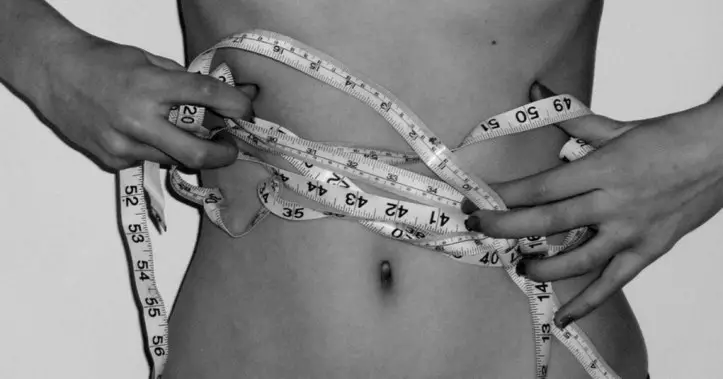Wednesday August 7, 2019 By: Lara Ahmed

Summer is clearly in the air, and the heat wave has people rushing to beaches to cool off and have fun. Everyone is slipping confidently into their new swimsuits and favorite shorts. Everyone, except for the women who can already hear the whispered disapproval of their bodies.
Body- shaming remains a pressing issue that womenknow too well. The stereotypes and insults that make up this abuse can cause victims to develop health issues ranging from depression to bulimia. Though the Arab world is beginning to see how strongly heavier people are targeted, it still hasn’t acknowledged the other side of the coin: skinny-shaming.
Beauty standards in Egypt aren’t clearly defined. Many preferences and expectations directly contradict each other. One moment curly hair is declaredtoo “wild”for a lady. The next, it is held up as an Arab woman’s crown. Similarly, skinnier women might affectionately be called “petite” or “feminine”, but then mocked for not having “trademark” Arab curves.
Fat-shaming is vile behavior, but it is just one example of weight-stigma rather than the complete definition of it. A closer look reveals that skinny and fat-shaming victims have more in common than they might think.

Skinny- shaming and social inequality
Throughout history, women were taught that their physical appearance was the ticket to a better life, checking off all the right boxes of love and social acceptance. While women and men are beginning to fight discrimination by embracing curves, many are unconsciously maintaining it by bullying skinnier women.
In a time where Egypt’s obesity epidemic is hiding in plain sight, skinny-shaming might not look like a big deal. Yet, this form of weight bias is just another way to trivialize women. As such, it widens the gap between male and female equality.
This goes back to the age-old belief that a woman’s appearance is her weak point. People believe that by hitting that spot, they could take down even the strongest women. For instance, when a woman is at the center of a heated discussion, those with opposing opinions steer away from the issue at hand by criticizing her outer appearance. By maintaining this attitude, society suggests that a woman is only as good as her body. Consequently, these people then choose to focus on how the woman looks, rather than what she has to say. Skinny-shaming is one way this commonly happens, but it gets especially trickier to tackle because thinner women are seen as being socially privileged.

Different victims, same crime
Some people might harbor bitterness because of how often they’re body-shamed, and occasionally lash out at skinnier women without even realizing it. There’s no wonder this occurs, since many women have been conditioned to be competitive about their looks.
Even if some feel that heavier women suffer the most, there’s no denying that skinny and fat- shaming shares some parallels. For example, heavier and thinner women alike sometimes avoid going to the gym because they don’t want to be mocked for trying to get in shape. Similarly, society dismisses the fact that many overweight and underweight people often have medical issues that prevent them from achieving their ideal figure. What’s more, skinny and heavier women similarly suffer through insults disguised as concern for their health. As if that’s not enough, women of both body types have numerous experiences of their weight being made fun of in public. Whether it’s having too much curves or not enough, women’s femininity always seems up for questioning.
While some women might have the emotional tools to cut through society’s more complex webs, many suffocate under social expectations. Consequently the topic takes on a more urgent tone, as society uses different knives to create the same scars.
Insecurity is just the beginning
This brings us to eating disorders. Arabs are now mentioning such conditions in daily conversation, but these words have also become weapons to beat thinner women with. Skinny women are all too familiar with the false concern attached to the question, “Are you anorexic?” Being defined by an illness she may or may not have, can understandably set a woman on a path of self-hatred and consistent doubt.
Fortunately, the wider public is beginning to acknowledge certain psychological and eating disorders related to weight-bias, but it’s worth learning about a lesser-known conditions that often makes this happen, such as body dysmorphic disorder (BDD). BDD is a disease that is typically a direct result of body-shaming. People with this mental disorder find themselves growing alarmingly obsessed with their body shape or certain facial features. Whether these feelings are triggered by people’s criticism or media messages, the disorder causes victims severe emotional distress that can even result in suicide. Seeing this in the context of skinny-shaming shows that there is a dark side to being considered too thin.

Measuring more than weight
Of course, as women go through life they realize that there is no such thing as the perfect body. Supermodels might be praised for their smaller waists or flatter-chests, but average women are called “stick-figures” and “pencil-thin” for having the same bodies. Meanwhile, curvy people are bullied into believing they’re only a few pounds away from becoming morbidly obese. Rather than treat body-shaming as a war against plus-size and size- zero, we should set our sights on the real problem. Telling women that one body type is more desirable than another suggests that changing their appearance will fix the problem, but all this does is wrongfully place blame on the victims. Time has taught that weight- stigma never really goes away, the targets just change.
If society discourages an environment against common forms of bullying, it will create opportunities to go back to the roots of gender equality. Fortunately, people now have many ways to redefine the way they look at body-shaming. Those curious can look anywhere from their own neighborhood to the internet to see how language used in everyday conversation can affect a person. Avoiding negative terms and politely telling others to do the same, can help the world see appearance as being second-rate to people’s inner qualities.
But, how’s this for a healthy start?
Embrace universal body-positivity without letting it define a woman’s sense of worth.
***If you liked this article, subscribe to the magazine and receive our articles in your email.
